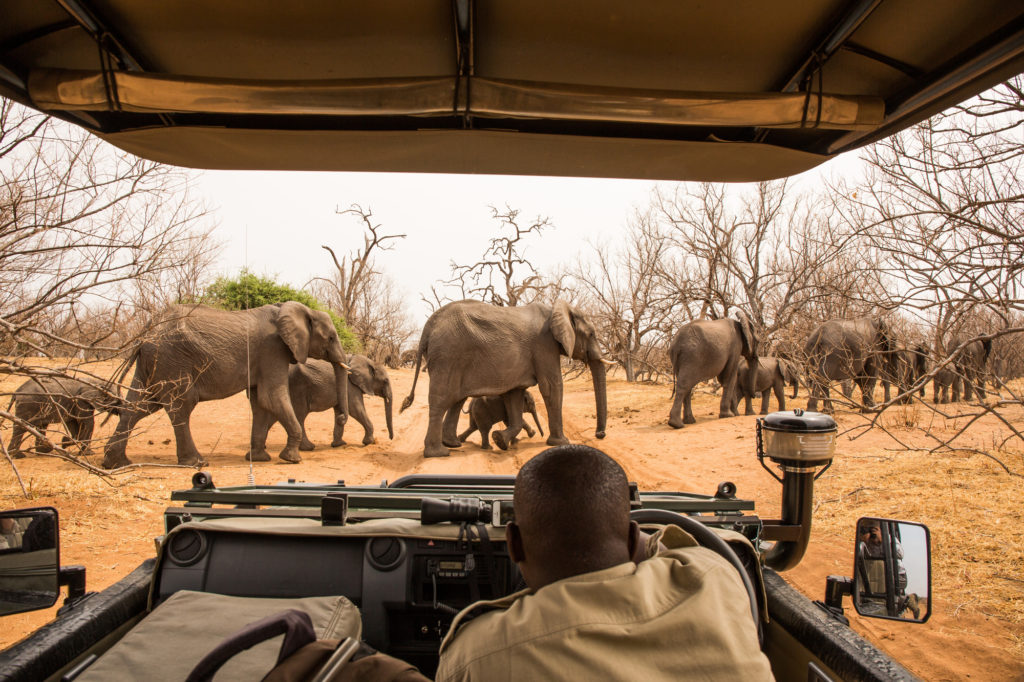Africa Travel Guide: How to Plan an Unforgettable Safari
A visit to Africa won’t be complete without a safari. This Africa travel guide will tell you everything you need to know so you can plan an unforgettable trip.
Two lion cubs sit on the banks of a small lake with their backs to us, their eyes glued to birds nested in the white-barked remnants of a dead tree jutting up from the water. A lanky giraffe lounges in the middle of the road pondering our truck, its lashed eyes blinking in the late afternoon heat. No Africa travel guide would be complete without discussing how to plan a successful wildlife safari.
Yes, it might be the most expensive trip you’ll ever take, but this experience will create unforgettable memories. Read on to learn more about planning a trip to Africa, and, more specifically, how to plan a safari.
Prepare for Sticker Shock
Let’s get one thing straight. African safaris are expensive. Get ready for some serious sticker shock. For example, if you plan on bringing a family of four, this could represent the single largest investment you’ve made since purchasing your house or car!
Safari prices range from $2,000 to $50,000 depending on your destination, length of stay, transportation, and types of accommodation. Yes, $50,000 sounds like a lot of money. If your safari involves staying in posh lodgings at $4,000 per night and taking small aircraft to reach inaccessible areas, these costs add up.
You don’t have to commit to shelling out tens of thousands of dollars per person to have an extraordinary experience. You can cut costs by opting for an off-season safari.
You can also economize by choosing a destination that doesn’t require as much driving. For example, Kruger National Park in South Africa might prove a more attainable destination than Tanzania.
Why? Unlike Tanzania’s parks, which require lots of driving and extra days, Kruger Park Tours can get you around South Africa’s national park in three or four days. while still affording you a full view of what the area has to offer.
Decide Where You Want to Go
When it comes to safari planning, the destination that you choose has a huge impact on the price of your safari. Where to go on safari in Africa? That depends on what you most want to see.
Start by researching which destination you’d most like to visit. That way, you can budget time and money accordingly.
Consider factors such as what you most want to see, special travel needs such as family tours, your budget, and how many days you’d like to be out on the road.
Many people travel to Africa to see the “Big Five” in their native environments:
- lions
- leopards
- rhinoceroses
- elephants
- Cape buffalos
Big five populations exist in parks across South Africa, Kenya, Tanzania, Botswana, and Zimbabwe. Of course, there are no guarantees all five will show up on your particular safari.
You’re dealing with wild animals, after all. You definitely up your odds of seeing them in these locations, however.
If you’re longing for specific geographical experiences, you’ll want to keep those in mind, too.
For example, if you’ve always dreamed of seeing Mount Kilimanjaro, you’re better off starting in Tanzania.
The same goes for the Great Migration, but more about that in a bit.
Let’s delve into the highlights of three Big Five locations so that you get a clear sense of which destination feels right for you. As you’ll soon realize, the diversity of the African continent proves remarkable and breathtaking.
South African Safaris
Among the best spots in South Africa to observe the Big Five, Kruger National Park ranks at the top of the list. Located in the northeastern portion of the country, it’s one of the largest game preserves in the world. It covers a whopping 7,523 square miles (19,485 square kilometers) within the provinces of Mpumalanga and Limpopo.
Located in the Lowveld of Mpumalanga, the Sabi Sands Game Reserve sits adjacent to Kruger National Park. Named after the Sabie River, which flows along its southern border, the reserve measures 250 square miles (650 square kilometers) and contains smaller private game reserves. Here, leopards are common, and most tours report seeing all five prized animals within a couple of days.
If you’re looking for a family-friendly experience without malaria-carrying mosquitos, consider the Eastern Cape or the Madikwe Private Game Reserve. Both afford excellent views of the Big Five although leopards tend to remain more elusive here.
A place like Kruger National Park has a lot to see in a reasonably small geographic space. That means you can see the full park in less than a week. This proves economical, particularly for families on the go.
Kenyan Safaris
If you can’t get enough of the adrenaline-packed movement of wildebeests, zebras, and other herd animals across the plains of Africa, then you’ll want to visit the Masai Mara of Kenya. Many people forget that Kenya also contains populations of the Big Five.
Of course, your travel plans must coincide with the time of year when the action typically occurs.
For example, in Kenya, the migration lasts from August to November with excellent chances of catching lions on the hunt at this time of year, too.
Tanzanian Safaris
Tanzania’s Serengeti and Ngorongoro Crater offer amazing views of the Great Migration, too, which stretches from November to July here. While Tanzania also boasts populations of the Big Five, it’s open grasslands appeal to herd animals more than rhinos and elephants. So, if your primary goal proves seeing the Big Five, stick with South Africa.
That said, the African Serengeti remains iconic for many reasons. The sheer abundance of wildlife and endlessly stretching plains is amazing. If seeing large cats ranks at the top of your list, your odds prove good here.
During the Great Migration, you’re likely to see lions hunting or enjoying a fresh kill. Because the plains lack trees, you also stand a better chance of spotting leopards, which is difficult work in heavily wooded areas.
Plan in Advance
Now that you’ve nailed down your destination and wildlife viewing priorities, let’s discuss how far in advance you should plan a safari. If you wish to plan the perfect safari during peak season, start booking at least a year in advance.
That said, planning an African safari on your own could lead to frustration. For example, Tanzanian roads are notoriously poor and most remain unmarked. This makes driving around the country almost impossible.
What’s more, many rental companies refuse to rent to individuals. For a variety of reasons from safety, efficiency, and the best use of your money, it makes the most sense to go with a safari tour company.
To find the right tour company for your ideal safari, start with a little research. Get familiar with a company’s offerings. Check out customer reviews to get a better sense of how well they deliver on the promises that they make. You’ll also notice that most safari companies provide tiered services. They range from high-end luxury excursions to budget-level expeditions.
Glamping Not Camping
When it comes to the experience of “camping” in Africa, it’s a far cry from the one-man-tent-on-bumpy-ground that we envision stateside. Think of safari camping more like glamping, particularly if you stay in tented camps.
Unlike lodges, which isolate you from nature, tented camps provide the best of camping without the hardships. On one hand, you get to enjoy nature up close and personal with the sounds of wildlife beyond your tent walls. It’s also an intimate experience in keeping with the adventurous spirit of a safari.
On the other hand, your accommodations feel luxurious. Yes, you may stay under a canvas roof surrounded by canvas walls, but you’ll enjoy indoor plumbing, full-size beds, and fresh food. Yet, despite all these comforts, you can still spend your evenings by a campfire beneath a glorious diamond-smattering of stars.
Tips for Better Travels
If everything you’ve read so far sounds amazing–except for the price–don’t despair. There are ways to cut expenses while still enjoying an outstanding African experience.
First, look for a budget camping safari. It’s an outfit that comes complete with a driver-guide and cook.
You’ll usually make camp in the evenings in places with showers and bathrooms. Your crew will put up your tents each night (including mattresses). A budget camping safari represents a great way to cut costs while still enjoying a once-in-a-lifetime safari experience.
Besides opting for a budget camping safari, you should also research taking a safari during the off-season. In the springtime, tourist numbers drop, which means lodges and camps reduce prices by as much as half their usual cost.
Don’t worry about missing out on animals. During the spring, Africa proves particularly lush and green, and there are many baby animals to see. What’s more, if you’d prefer to avoid the crowds, there’s no better time to visit.
Africa Travel Guide
No Africa travel guide would prove complete without an iconic African safari. Finding the right destination and accommodations for your safari requires research and planning though. Of course, these extra efforts will prove well worth it once you’re enjoying the breathtaking outcome.
Interested in learning about what to expect on your first African safari vacation? Follow my Stayful blog for tips on how to pursue your dream life with a healthy dose of adventure on the side!
Or, contact me with your questions and comments. I look forward to hearing from you.




